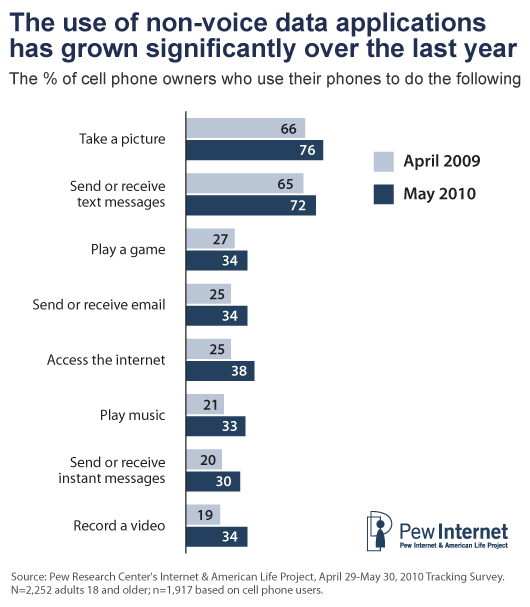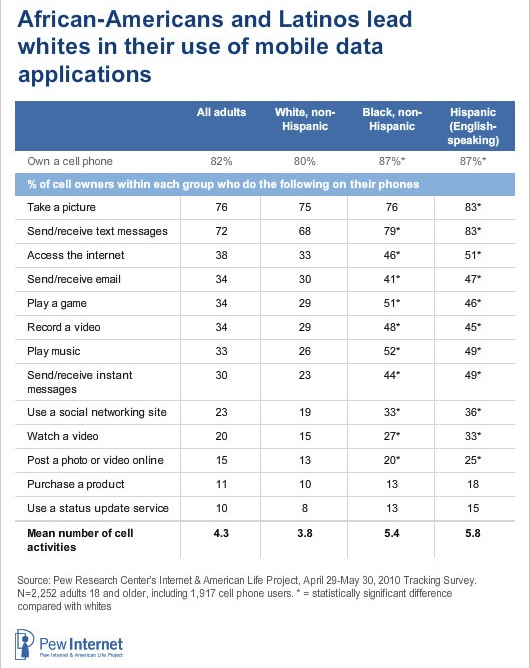The Mobile Web is NOW (tough luck PCs)
The mobile Web isn't a future event. It's here today, at least in the United States, according to a 25-page report PEW Internet released this week. The study's findings are hugely significant to companies like Microsoft, which is largely invested in the PC, and Apple or Google, which embrace mobile devices and cloud services.
"Fifty-nine percent of American adults now go online wirelessly using either a laptop or cell phone, an increase over the 51 percent of Americans who did so at a similar point in 2009," according to the key findings. Some of the numbers will seem low, such as 38 percent accessing the Internet from their cell phones. Just the opposite: PEW looked more broadly at cell phones -- not just smartphones, which in other studies ranked higher for Internet and applications use. PEW captures demographic data that is startlingly revealing, though unsurprising. For example, 65 percent of 18-29 year olds access the Internet from their cell phones.
Mobile Youth Lead the Way
Young adults clearly are leading the way to the mobile Web, and they're a group no company offering mobile hardware, software or services should ignore. Twenty-nine year olds are at the cusp of where Generation X meets Gen Y (also called Echo Boomers or Millennials), which population is a little larger than Baby Boomers. The trailing end Gen Y's would be about 9 years old. PEW's study doesn't include teens, which connected, mobile habits are likely more pronounced than their older Millennials peers.
"Nine in ten 18-29 year olds own a cell phone, and these young cell owners are significantly more likely than those in other age groups to engage in all of the mobile data applications we asked about in our survey," according to the PEW report. "Other age groups" refers to older Americans, not teenagers or younger.
Some provocative usage highlights among 18-29 year olds:
- 93 percent take photos on their phones
- 81 percent transmit photos or videos from their phones
- 60 percent play games or record videos on their phones
- 52 percent use their phones to read or send e-mail
- 48 percent access social networking services on their phones
- 40 percent watch videos on their phones
- 20 percent make purchases using their phones
- 17 percent make charitable donations by text messages

In context of this data, Microsoft's killing off KIN is all the more tragic. Microsoft had the right concepts down for KIN, which features hugely resonate what Gen Ys do with their mobiles.
According to PEW: "19 percent of 18-29 year olds are cell-only wireless users, compared with 13 percent of 30-49 year olds, 9 percent of 50-64 year olds and 5 percent of those ages 65 and older." That means nearly one in five young American adults accesses the Internet only through cell phone -- not personal computer, too.

No wonder AT&T capped data usage, while T-Mobile switched, in October, to unlimited data plans. T-Mobile's plan change make loads of sense in context of this data point and another: "17 percent of those earning less than $30,000 per year are cell-only wireless users." Based on T-Mobile public information and other analyst data, the carrier hugely appeals to younger and lower-income Americans. In that context, the unlimited data plans cater to the right customers.
They Find Time to Go Online
Overall, Americans are surprisingly likely to go online from their cell phones. Among those going online, more than 50 percent do so at least once a day. Some of the demographic breakdowns, according to PEW:
Among those who go online using a handheld device 55 percent of English-speaking Hispanics, 52 percernt of college graduates and 56 percent of those with a household income of $75,000 or more per year use their cell phone to go online several times a day. Young adults are also intense mobile internet users -- 52 percent of those ages 18-29 who go online using a cell phone do so several times a day, and an additional 17 percent do so about once a day -- although 43 percent of mobile web users ages 30-49 go online multiple times a day.

Another finding differentiates the US's two main minority groups in terms of their wireless Internet usage:
Nearly two-thirds of African-Americans (64 percent) and Latinos (63 percent) are wireless internet users, and minority Americans are significantly more likely to own a cell phone than their white counterparts (87 percent of blacks and Hispanics own a cell phone, compared with 80 percent of whites). Additionally, black and Latino cell phone owners take advantage of a much wider array of their phones' data functions compared to white cell phone owners.
It's not a white world of connected, mobile users. Mobile hardware, software and services providers should closely look at these demographic differences, particularly as they seek to broaden the appeal of smartphones and mobile applications and services.

The report is more broad than this quick synopsis. It's a great read and excellent companion to February PEW report "Millennials: A Portrait of Generation Next." More significantly, the report is further conformation that mobile devices, particularly cell phones, are rapidly replacing PCs as primary connected, computing devices. "The Windows era is Over."